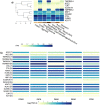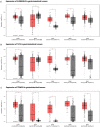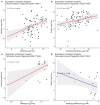Increased TRIM31 gene expression is positively correlated with SARS-CoV-2 associated genes TMPRSS2 and TMPRSS4 in gastrointestinal cancers
- PMID: 35970857
- PMCID: PMC9378649
- DOI: 10.1038/s41598-022-15911-2
Increased TRIM31 gene expression is positively correlated with SARS-CoV-2 associated genes TMPRSS2 and TMPRSS4 in gastrointestinal cancers
Abstract
Besides typical respiratory symptoms, COVID-19 patients also have gastrointestinal symptoms. Studies focusing on the gastrointestinal tumors derived from gastrointestinal tissues have raised a question whether these tumors might express higher levels of SARS-CoV-2 associated genes and therefore patients diagnosed with GI cancers may be more susceptible to the infection. In this study, we have analyzed the expression of SARS-CoV-2 associated genes and their co-expressions in gastrointestinal solid tumors, cancer cell lines and patient-derived organoids relative to their normal counterparts. Moreover, we have found increased co-expression of TMPRSS2-TMPRSS4 in gastrointestinal cancers suggesting that SARS-CoV-2 viral infection known to be mediated by this protease pair might facilitate the effects of viral infection in GI cancer patients. Further, our findings also demonstrate that TRIM31 expression is upregulated in gastrointestinal tumors, while the inhibition of TRIM31 significantly altered viral replication and viral processes associated with cellular pathways in gastrointestinal cancer samples. Taken together, these findings indicate that in addition to the co-expression of TMPRSS2-TMPRSS4 protease pair in GI cancers, TRIM31 expression is positively correlated with this pair and TRIM31 may play a role in providing an increased susceptibility in GI cancer patients to be infected with SARS-CoV-2 virus.
© 2022. The Author(s).
Conflict of interest statement
The authors declare no competing interests.
Figures






Similar articles
-
Characteristics of Angiotensin I-converting enzyme 2, type II transmembrane serine protease 2 and 4 in tree shrew indicate it as a potential animal model for SARS-CoV-2 infection.Bioengineered. 2021 Dec;12(1):2836-2850. doi: 10.1080/21655979.2021.1940072. Bioengineered. 2021. PMID: 34227905 Free PMC article.
-
Prostate adenocarcinoma and COVID-19: The possible impacts of TMPRSS2 expressions in susceptibility to SARS-CoV-2.J Cell Mol Med. 2021 Apr;25(8):4157-4165. doi: 10.1111/jcmm.16385. Epub 2021 Feb 20. J Cell Mol Med. 2021. PMID: 33609069 Free PMC article.
-
Computational analysis of TMPRSS2 expression in normal and SARS-CoV-2-infected human tissues.Chem Biol Interact. 2021 Sep 1;346:109583. doi: 10.1016/j.cbi.2021.109583. Epub 2021 Jul 17. Chem Biol Interact. 2021. PMID: 34284028 Free PMC article.
-
Polymorphisms and mutations of ACE2 and TMPRSS2 genes are associated with COVID-19: a systematic review.Eur J Med Res. 2022 Feb 22;27(1):26. doi: 10.1186/s40001-022-00647-6. Eur J Med Res. 2022. PMID: 35193695 Free PMC article.
-
The secret identities of TMPRSS2: Fertility factor, virus trafficker, inflammation moderator, prostate protector and tumor suppressor.Tumour Biol. 2021;43(1):159-176. doi: 10.3233/TUB-211502. Tumour Biol. 2021. PMID: 34420994 Review.
Cited by
-
SCAT8/miR-125b-5p axis triggers malignant progression of nasopharyngeal carcinoma through SCARB1.BMC Mol Cell Biol. 2023 Apr 3;24(1):15. doi: 10.1186/s12860-023-00477-2. BMC Mol Cell Biol. 2023. PMID: 37009875 Free PMC article.
-
Pan-Cancer Analysis of the COVID-19 Causal Gene SLC6A20.ACS Omega. 2023 Mar 31;8(14):13153-13161. doi: 10.1021/acsomega.3c00407. eCollection 2023 Apr 11. ACS Omega. 2023. PMID: 37041751 Free PMC article.
-
Extracellular vesicles derived from SARS-CoV-2 M-protein-induced triple negative breast cancer cells promoted the ability of tissue stem cells supporting cancer progression.Front Oncol. 2024 Mar 7;14:1346312. doi: 10.3389/fonc.2024.1346312. eCollection 2024. Front Oncol. 2024. PMID: 38515582 Free PMC article.
-
Role of E3 ubiquitin ligases and deubiquitinating enzymes in SARS-CoV-2 infection.Front Cell Infect Microbiol. 2023 Jun 9;13:1217383. doi: 10.3389/fcimb.2023.1217383. eCollection 2023. Front Cell Infect Microbiol. 2023. PMID: 37360529 Free PMC article. Review.
-
Current Technologies and Future Perspectives in Immunotherapy towards a Clinical Oncology Approach.Biomedicines. 2024 Jan 18;12(1):217. doi: 10.3390/biomedicines12010217. Biomedicines. 2024. PMID: 38255322 Free PMC article. Review.
References
-
- World Health Organization. Novel Coronavirus—China. https://www.who.int/emergencies/disease-outbreak-news/item/2020-DON233 (2020).
-
- World Health Organization. WHO Coronavirus (COVID-19) Dashboard | WHO Coronavirus (COVID-19) Dashboard With Vaccination Data. https://covid19.who.int/.
-
- Charles G, Anderson-Nathe B. The way ahead past COVID: Worse than before. Child Youth Serv. 2021;42:1–2. doi: 10.1080/0145935X.2021.1953771. - DOI
Publication types
MeSH terms
Substances
LinkOut - more resources
Full Text Sources
Molecular Biology Databases
Miscellaneous

